Anatomy and Physiology for H&SC: Structures, Functions, and Homoeostasis in Human Body
VerifiedAdded on 2023/06/08
|10
|3105
|231
AI Summary
This article covers the anatomy and physiology of the human body, including the structures and functions of organ systems, the process of homoeostasis, and the relationship between the nervous and endocrine systems. It also discusses factors that may impact physiological measurements and how to gain consent prior to obtaining them.
Contribute Materials
Your contribution can guide someone’s learning journey. Share your
documents today.
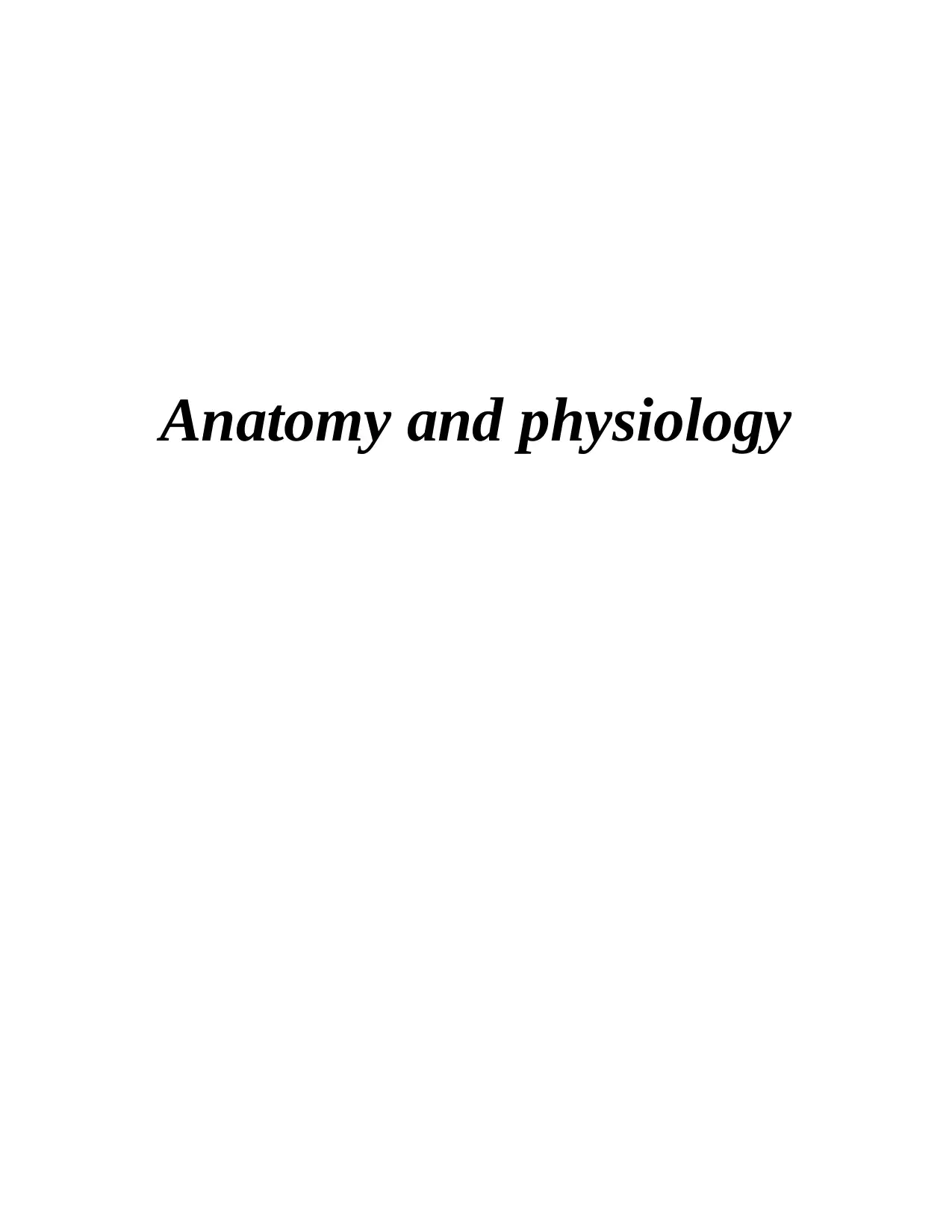
Anatomy and physiology
Secure Best Marks with AI Grader
Need help grading? Try our AI Grader for instant feedback on your assignments.
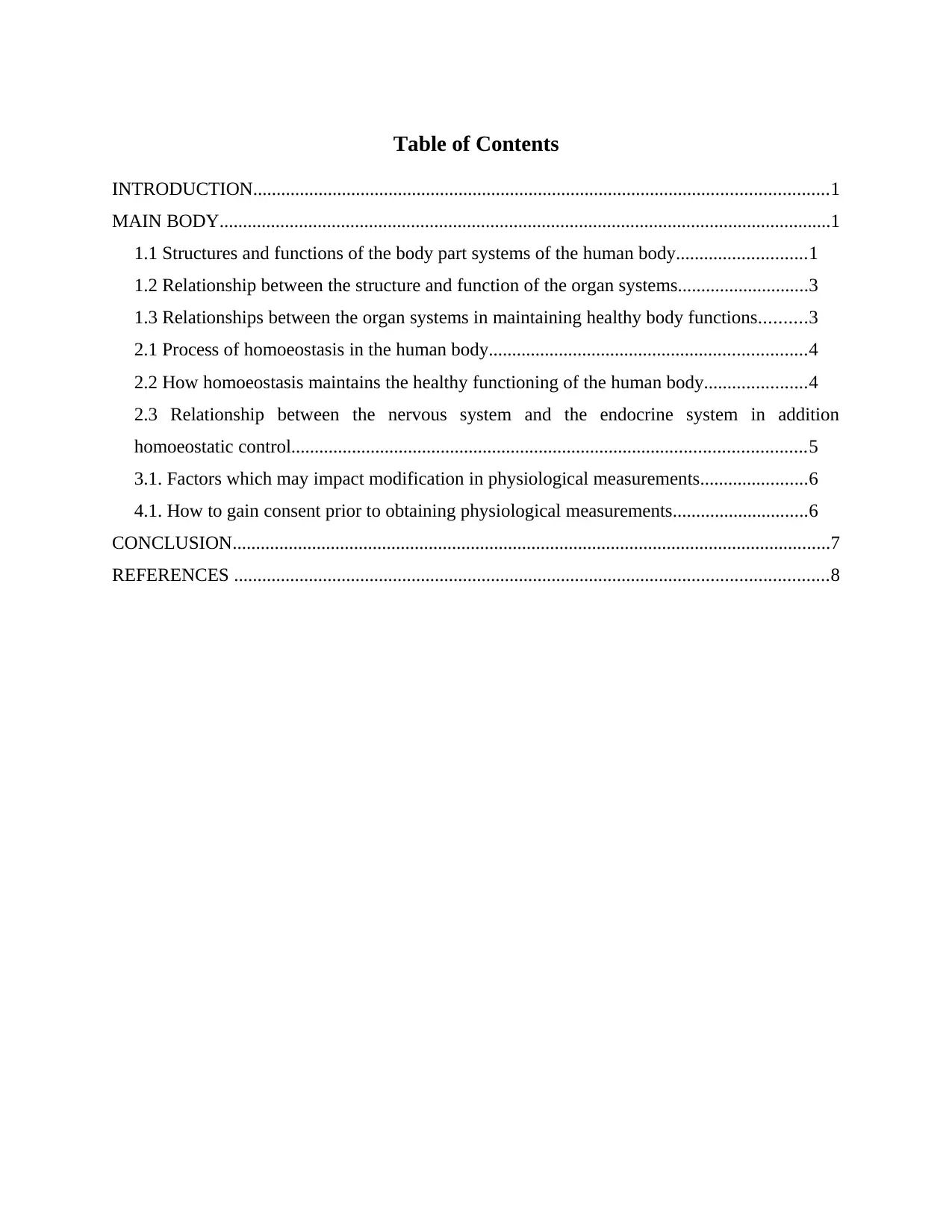
Table of Contents
INTRODUCTION...........................................................................................................................1
MAIN BODY...................................................................................................................................1
1.1 Structures and functions of the body part systems of the human body............................1
1.2 Relationship between the structure and function of the organ systems............................3
1.3 Relationships between the organ systems in maintaining healthy body functions..........3
2.1 Process of homoeostasis in the human body....................................................................4
2.2 How homoeostasis maintains the healthy functioning of the human body......................4
2.3 Relationship between the nervous system and the endocrine system in addition
homoeostatic control..............................................................................................................5
3.1. Factors which may impact modification in physiological measurements.......................6
4.1. How to gain consent prior to obtaining physiological measurements.............................6
CONCLUSION................................................................................................................................7
REFERENCES ...............................................................................................................................8
INTRODUCTION...........................................................................................................................1
MAIN BODY...................................................................................................................................1
1.1 Structures and functions of the body part systems of the human body............................1
1.2 Relationship between the structure and function of the organ systems............................3
1.3 Relationships between the organ systems in maintaining healthy body functions..........3
2.1 Process of homoeostasis in the human body....................................................................4
2.2 How homoeostasis maintains the healthy functioning of the human body......................4
2.3 Relationship between the nervous system and the endocrine system in addition
homoeostatic control..............................................................................................................5
3.1. Factors which may impact modification in physiological measurements.......................6
4.1. How to gain consent prior to obtaining physiological measurements.............................6
CONCLUSION................................................................................................................................7
REFERENCES ...............................................................................................................................8
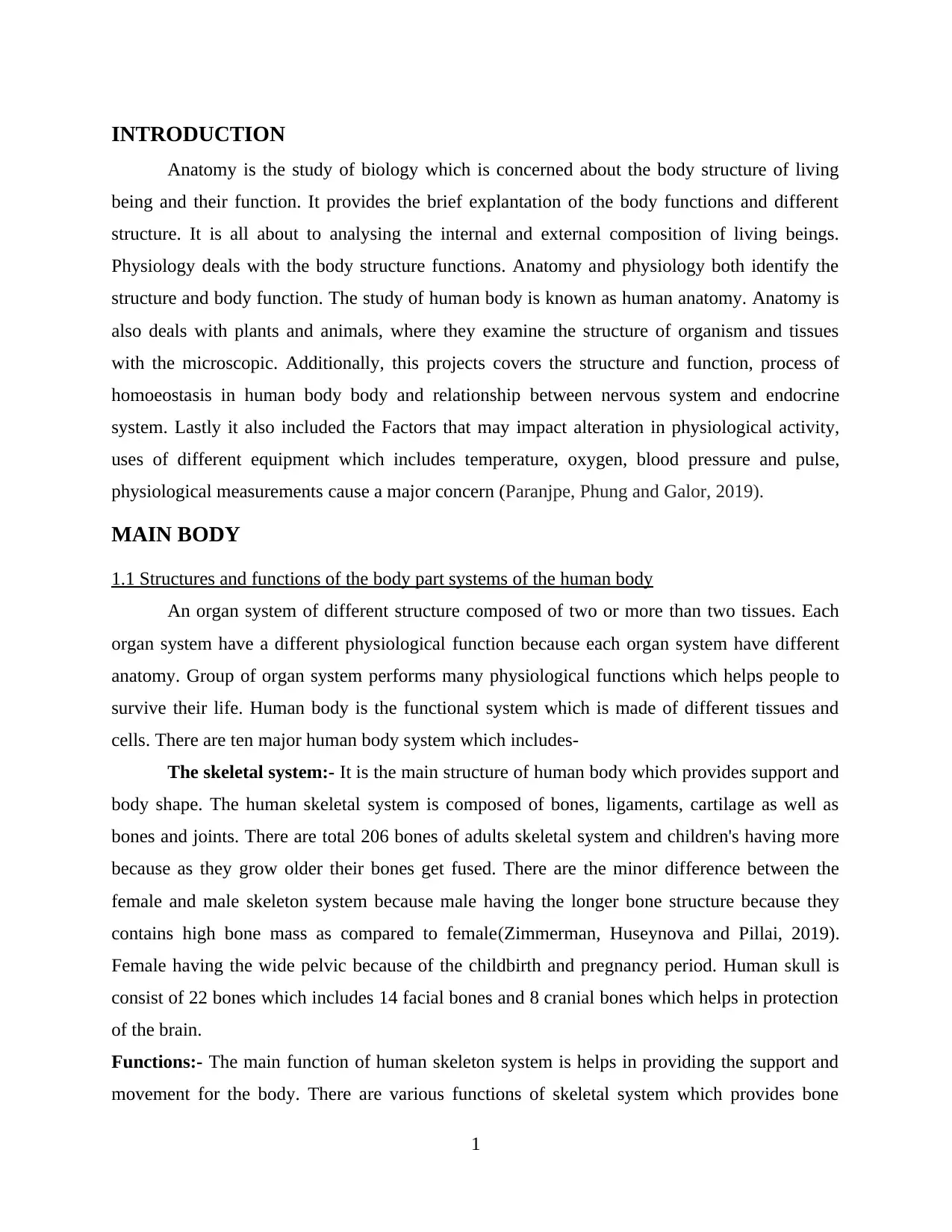
INTRODUCTION
Anatomy is the study of biology which is concerned about the body structure of living
being and their function. It provides the brief explantation of the body functions and different
structure. It is all about to analysing the internal and external composition of living beings.
Physiology deals with the body structure functions. Anatomy and physiology both identify the
structure and body function. The study of human body is known as human anatomy. Anatomy is
also deals with plants and animals, where they examine the structure of organism and tissues
with the microscopic. Additionally, this projects covers the structure and function, process of
homoeostasis in human body body and relationship between nervous system and endocrine
system. Lastly it also included the Factors that may impact alteration in physiological activity,
uses of different equipment which includes temperature, oxygen, blood pressure and pulse,
physiological measurements cause a major concern (Paranjpe, Phung and Galor, 2019).
MAIN BODY
1.1 Structures and functions of the body part systems of the human body
An organ system of different structure composed of two or more than two tissues. Each
organ system have a different physiological function because each organ system have different
anatomy. Group of organ system performs many physiological functions which helps people to
survive their life. Human body is the functional system which is made of different tissues and
cells. There are ten major human body system which includes-
The skeletal system:- It is the main structure of human body which provides support and
body shape. The human skeletal system is composed of bones, ligaments, cartilage as well as
bones and joints. There are total 206 bones of adults skeletal system and children's having more
because as they grow older their bones get fused. There are the minor difference between the
female and male skeleton system because male having the longer bone structure because they
contains high bone mass as compared to female(Zimmerman, Huseynova and Pillai, 2019).
Female having the wide pelvic because of the childbirth and pregnancy period. Human skull is
consist of 22 bones which includes 14 facial bones and 8 cranial bones which helps in protection
of the brain.
Functions:- The main function of human skeleton system is helps in providing the support and
movement for the body. There are various functions of skeletal system which provides bone
1
Anatomy is the study of biology which is concerned about the body structure of living
being and their function. It provides the brief explantation of the body functions and different
structure. It is all about to analysing the internal and external composition of living beings.
Physiology deals with the body structure functions. Anatomy and physiology both identify the
structure and body function. The study of human body is known as human anatomy. Anatomy is
also deals with plants and animals, where they examine the structure of organism and tissues
with the microscopic. Additionally, this projects covers the structure and function, process of
homoeostasis in human body body and relationship between nervous system and endocrine
system. Lastly it also included the Factors that may impact alteration in physiological activity,
uses of different equipment which includes temperature, oxygen, blood pressure and pulse,
physiological measurements cause a major concern (Paranjpe, Phung and Galor, 2019).
MAIN BODY
1.1 Structures and functions of the body part systems of the human body
An organ system of different structure composed of two or more than two tissues. Each
organ system have a different physiological function because each organ system have different
anatomy. Group of organ system performs many physiological functions which helps people to
survive their life. Human body is the functional system which is made of different tissues and
cells. There are ten major human body system which includes-
The skeletal system:- It is the main structure of human body which provides support and
body shape. The human skeletal system is composed of bones, ligaments, cartilage as well as
bones and joints. There are total 206 bones of adults skeletal system and children's having more
because as they grow older their bones get fused. There are the minor difference between the
female and male skeleton system because male having the longer bone structure because they
contains high bone mass as compared to female(Zimmerman, Huseynova and Pillai, 2019).
Female having the wide pelvic because of the childbirth and pregnancy period. Human skull is
consist of 22 bones which includes 14 facial bones and 8 cranial bones which helps in protection
of the brain.
Functions:- The main function of human skeleton system is helps in providing the support and
movement for the body. There are various functions of skeletal system which provides bone
1
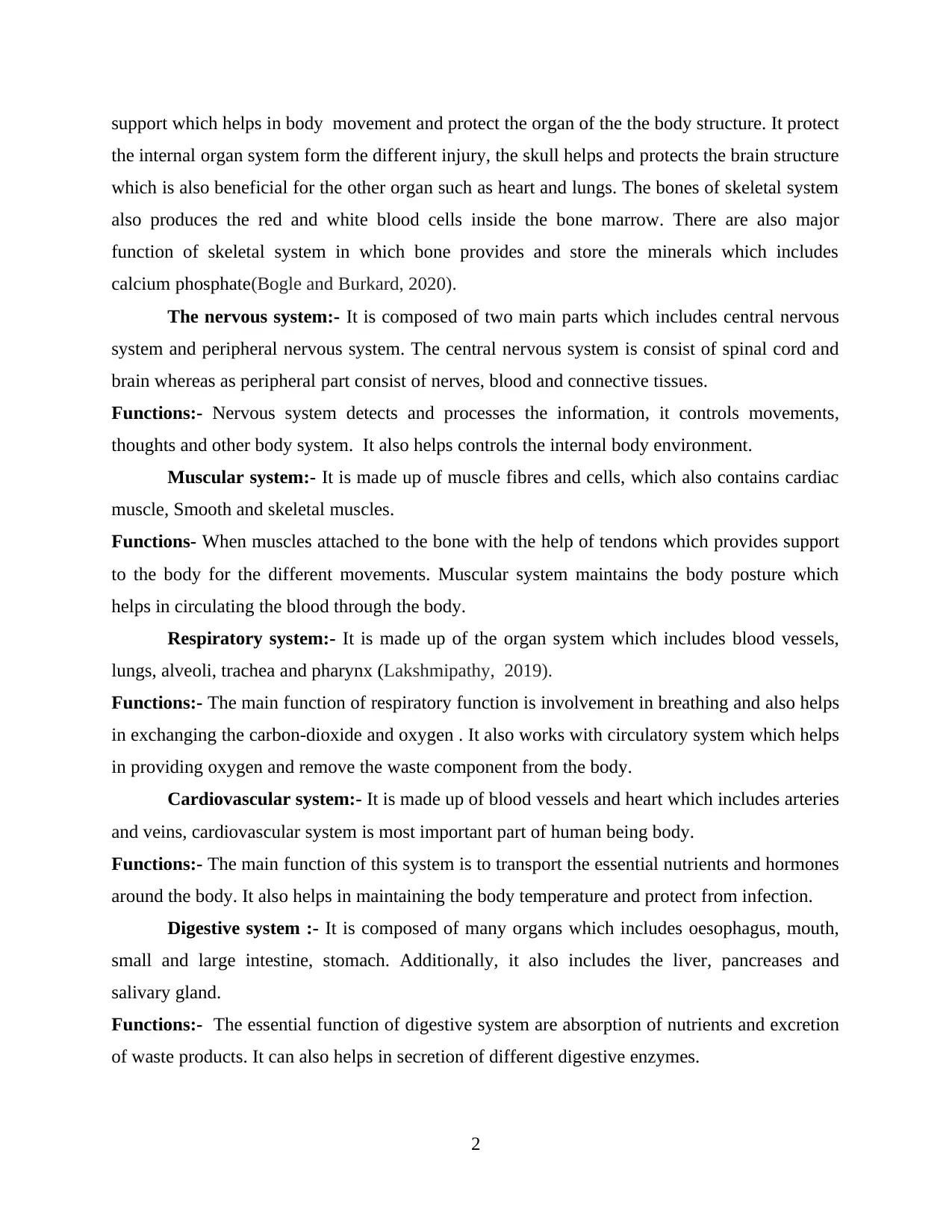
support which helps in body movement and protect the organ of the the body structure. It protect
the internal organ system form the different injury, the skull helps and protects the brain structure
which is also beneficial for the other organ such as heart and lungs. The bones of skeletal system
also produces the red and white blood cells inside the bone marrow. There are also major
function of skeletal system in which bone provides and store the minerals which includes
calcium phosphate(Bogle and Burkard, 2020).
The nervous system:- It is composed of two main parts which includes central nervous
system and peripheral nervous system. The central nervous system is consist of spinal cord and
brain whereas as peripheral part consist of nerves, blood and connective tissues.
Functions:- Nervous system detects and processes the information, it controls movements,
thoughts and other body system. It also helps controls the internal body environment.
Muscular system:- It is made up of muscle fibres and cells, which also contains cardiac
muscle, Smooth and skeletal muscles.
Functions- When muscles attached to the bone with the help of tendons which provides support
to the body for the different movements. Muscular system maintains the body posture which
helps in circulating the blood through the body.
Respiratory system:- It is made up of the organ system which includes blood vessels,
lungs, alveoli, trachea and pharynx (Lakshmipathy, 2019).
Functions:- The main function of respiratory function is involvement in breathing and also helps
in exchanging the carbon-dioxide and oxygen . It also works with circulatory system which helps
in providing oxygen and remove the waste component from the body.
Cardiovascular system:- It is made up of blood vessels and heart which includes arteries
and veins, cardiovascular system is most important part of human being body.
Functions:- The main function of this system is to transport the essential nutrients and hormones
around the body. It also helps in maintaining the body temperature and protect from infection.
Digestive system :- It is composed of many organs which includes oesophagus, mouth,
small and large intestine, stomach. Additionally, it also includes the liver, pancreases and
salivary gland.
Functions:- The essential function of digestive system are absorption of nutrients and excretion
of waste products. It can also helps in secretion of different digestive enzymes.
2
the internal organ system form the different injury, the skull helps and protects the brain structure
which is also beneficial for the other organ such as heart and lungs. The bones of skeletal system
also produces the red and white blood cells inside the bone marrow. There are also major
function of skeletal system in which bone provides and store the minerals which includes
calcium phosphate(Bogle and Burkard, 2020).
The nervous system:- It is composed of two main parts which includes central nervous
system and peripheral nervous system. The central nervous system is consist of spinal cord and
brain whereas as peripheral part consist of nerves, blood and connective tissues.
Functions:- Nervous system detects and processes the information, it controls movements,
thoughts and other body system. It also helps controls the internal body environment.
Muscular system:- It is made up of muscle fibres and cells, which also contains cardiac
muscle, Smooth and skeletal muscles.
Functions- When muscles attached to the bone with the help of tendons which provides support
to the body for the different movements. Muscular system maintains the body posture which
helps in circulating the blood through the body.
Respiratory system:- It is made up of the organ system which includes blood vessels,
lungs, alveoli, trachea and pharynx (Lakshmipathy, 2019).
Functions:- The main function of respiratory function is involvement in breathing and also helps
in exchanging the carbon-dioxide and oxygen . It also works with circulatory system which helps
in providing oxygen and remove the waste component from the body.
Cardiovascular system:- It is made up of blood vessels and heart which includes arteries
and veins, cardiovascular system is most important part of human being body.
Functions:- The main function of this system is to transport the essential nutrients and hormones
around the body. It also helps in maintaining the body temperature and protect from infection.
Digestive system :- It is composed of many organs which includes oesophagus, mouth,
small and large intestine, stomach. Additionally, it also includes the liver, pancreases and
salivary gland.
Functions:- The essential function of digestive system are absorption of nutrients and excretion
of waste products. It can also helps in secretion of different digestive enzymes.
2
Secure Best Marks with AI Grader
Need help grading? Try our AI Grader for instant feedback on your assignments.
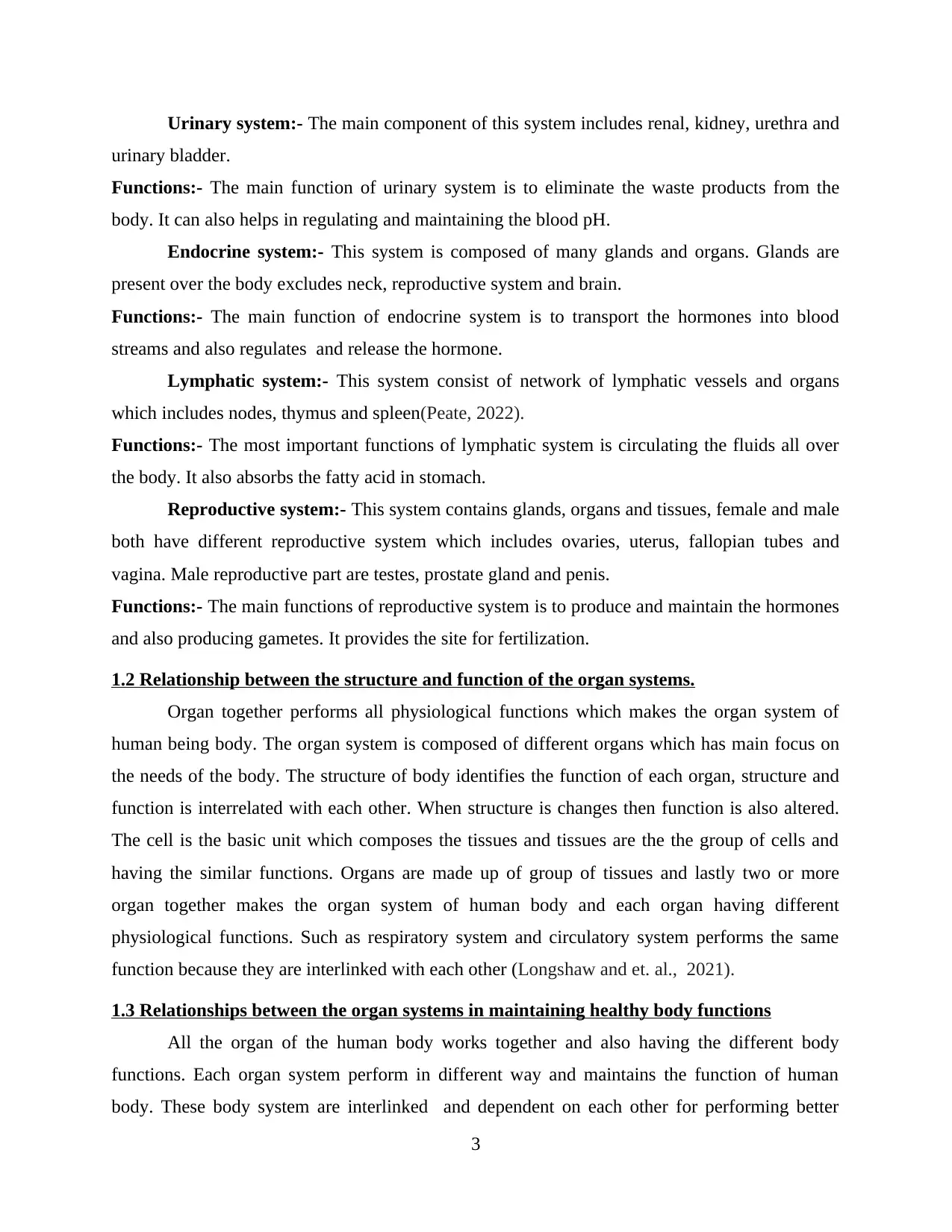
Urinary system:- The main component of this system includes renal, kidney, urethra and
urinary bladder.
Functions:- The main function of urinary system is to eliminate the waste products from the
body. It can also helps in regulating and maintaining the blood pH.
Endocrine system:- This system is composed of many glands and organs. Glands are
present over the body excludes neck, reproductive system and brain.
Functions:- The main function of endocrine system is to transport the hormones into blood
streams and also regulates and release the hormone.
Lymphatic system:- This system consist of network of lymphatic vessels and organs
which includes nodes, thymus and spleen(Peate, 2022).
Functions:- The most important functions of lymphatic system is circulating the fluids all over
the body. It also absorbs the fatty acid in stomach.
Reproductive system:- This system contains glands, organs and tissues, female and male
both have different reproductive system which includes ovaries, uterus, fallopian tubes and
vagina. Male reproductive part are testes, prostate gland and penis.
Functions:- The main functions of reproductive system is to produce and maintain the hormones
and also producing gametes. It provides the site for fertilization.
1.2 Relationship between the structure and function of the organ systems.
Organ together performs all physiological functions which makes the organ system of
human being body. The organ system is composed of different organs which has main focus on
the needs of the body. The structure of body identifies the function of each organ, structure and
function is interrelated with each other. When structure is changes then function is also altered.
The cell is the basic unit which composes the tissues and tissues are the the group of cells and
having the similar functions. Organs are made up of group of tissues and lastly two or more
organ together makes the organ system of human body and each organ having different
physiological functions. Such as respiratory system and circulatory system performs the same
function because they are interlinked with each other (Longshaw and et. al., 2021).
1.3 Relationships between the organ systems in maintaining healthy body functions
All the organ of the human body works together and also having the different body
functions. Each organ system perform in different way and maintains the function of human
body. These body system are interlinked and dependent on each other for performing better
3
urinary bladder.
Functions:- The main function of urinary system is to eliminate the waste products from the
body. It can also helps in regulating and maintaining the blood pH.
Endocrine system:- This system is composed of many glands and organs. Glands are
present over the body excludes neck, reproductive system and brain.
Functions:- The main function of endocrine system is to transport the hormones into blood
streams and also regulates and release the hormone.
Lymphatic system:- This system consist of network of lymphatic vessels and organs
which includes nodes, thymus and spleen(Peate, 2022).
Functions:- The most important functions of lymphatic system is circulating the fluids all over
the body. It also absorbs the fatty acid in stomach.
Reproductive system:- This system contains glands, organs and tissues, female and male
both have different reproductive system which includes ovaries, uterus, fallopian tubes and
vagina. Male reproductive part are testes, prostate gland and penis.
Functions:- The main functions of reproductive system is to produce and maintain the hormones
and also producing gametes. It provides the site for fertilization.
1.2 Relationship between the structure and function of the organ systems.
Organ together performs all physiological functions which makes the organ system of
human being body. The organ system is composed of different organs which has main focus on
the needs of the body. The structure of body identifies the function of each organ, structure and
function is interrelated with each other. When structure is changes then function is also altered.
The cell is the basic unit which composes the tissues and tissues are the the group of cells and
having the similar functions. Organs are made up of group of tissues and lastly two or more
organ together makes the organ system of human body and each organ having different
physiological functions. Such as respiratory system and circulatory system performs the same
function because they are interlinked with each other (Longshaw and et. al., 2021).
1.3 Relationships between the organ systems in maintaining healthy body functions
All the organ of the human body works together and also having the different body
functions. Each organ system perform in different way and maintains the function of human
body. These body system are interlinked and dependent on each other for performing better
3
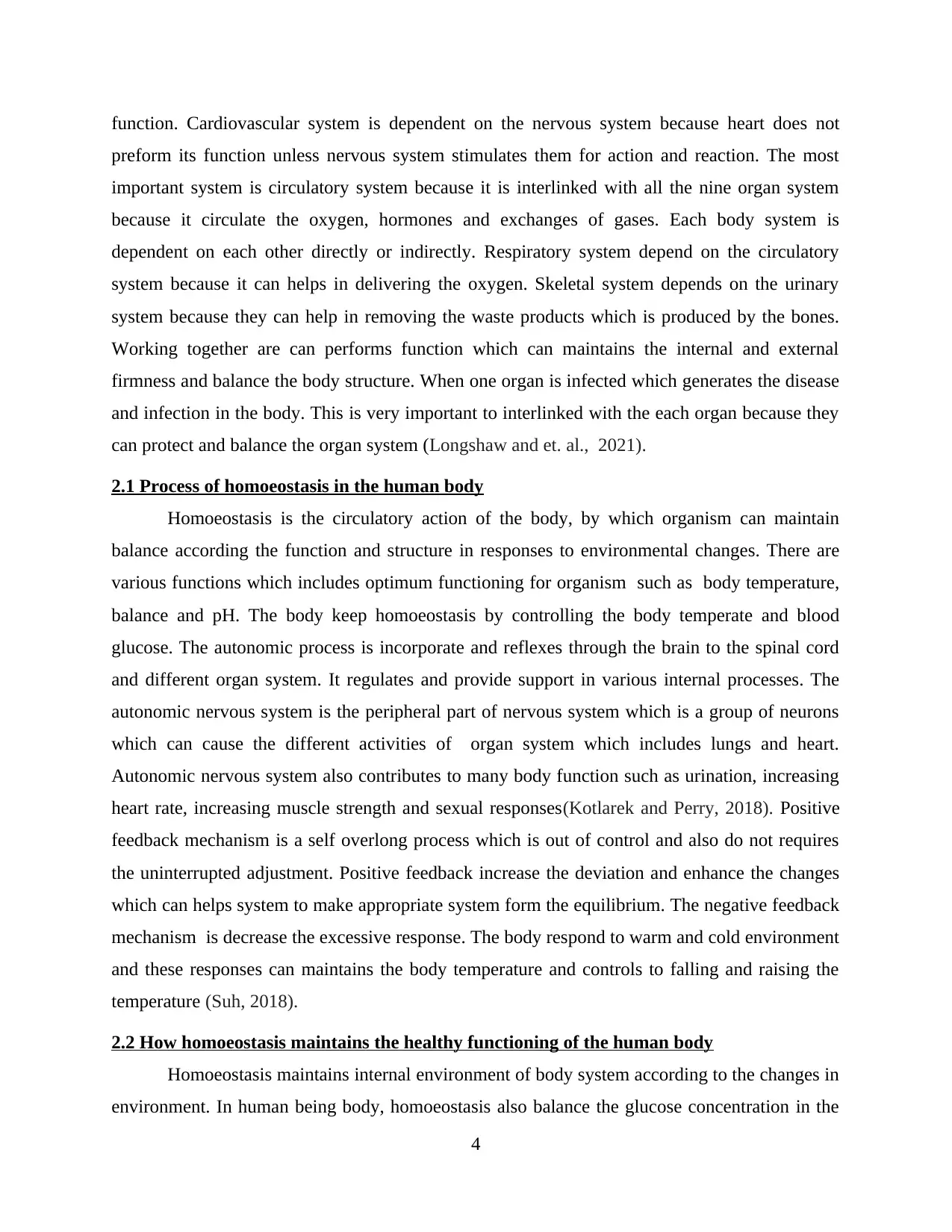
function. Cardiovascular system is dependent on the nervous system because heart does not
preform its function unless nervous system stimulates them for action and reaction. The most
important system is circulatory system because it is interlinked with all the nine organ system
because it circulate the oxygen, hormones and exchanges of gases. Each body system is
dependent on each other directly or indirectly. Respiratory system depend on the circulatory
system because it can helps in delivering the oxygen. Skeletal system depends on the urinary
system because they can help in removing the waste products which is produced by the bones.
Working together are can performs function which can maintains the internal and external
firmness and balance the body structure. When one organ is infected which generates the disease
and infection in the body. This is very important to interlinked with the each organ because they
can protect and balance the organ system (Longshaw and et. al., 2021).
2.1 Process of homoeostasis in the human body
Homoeostasis is the circulatory action of the body, by which organism can maintain
balance according the function and structure in responses to environmental changes. There are
various functions which includes optimum functioning for organism such as body temperature,
balance and pH. The body keep homoeostasis by controlling the body temperate and blood
glucose. The autonomic process is incorporate and reflexes through the brain to the spinal cord
and different organ system. It regulates and provide support in various internal processes. The
autonomic nervous system is the peripheral part of nervous system which is a group of neurons
which can cause the different activities of organ system which includes lungs and heart.
Autonomic nervous system also contributes to many body function such as urination, increasing
heart rate, increasing muscle strength and sexual responses(Kotlarek and Perry, 2018). Positive
feedback mechanism is a self overlong process which is out of control and also do not requires
the uninterrupted adjustment. Positive feedback increase the deviation and enhance the changes
which can helps system to make appropriate system form the equilibrium. The negative feedback
mechanism is decrease the excessive response. The body respond to warm and cold environment
and these responses can maintains the body temperature and controls to falling and raising the
temperature (Suh, 2018).
2.2 How homoeostasis maintains the healthy functioning of the human body
Homoeostasis maintains internal environment of body system according to the changes in
environment. In human being body, homoeostasis also balance the glucose concentration in the
4
preform its function unless nervous system stimulates them for action and reaction. The most
important system is circulatory system because it is interlinked with all the nine organ system
because it circulate the oxygen, hormones and exchanges of gases. Each body system is
dependent on each other directly or indirectly. Respiratory system depend on the circulatory
system because it can helps in delivering the oxygen. Skeletal system depends on the urinary
system because they can help in removing the waste products which is produced by the bones.
Working together are can performs function which can maintains the internal and external
firmness and balance the body structure. When one organ is infected which generates the disease
and infection in the body. This is very important to interlinked with the each organ because they
can protect and balance the organ system (Longshaw and et. al., 2021).
2.1 Process of homoeostasis in the human body
Homoeostasis is the circulatory action of the body, by which organism can maintain
balance according the function and structure in responses to environmental changes. There are
various functions which includes optimum functioning for organism such as body temperature,
balance and pH. The body keep homoeostasis by controlling the body temperate and blood
glucose. The autonomic process is incorporate and reflexes through the brain to the spinal cord
and different organ system. It regulates and provide support in various internal processes. The
autonomic nervous system is the peripheral part of nervous system which is a group of neurons
which can cause the different activities of organ system which includes lungs and heart.
Autonomic nervous system also contributes to many body function such as urination, increasing
heart rate, increasing muscle strength and sexual responses(Kotlarek and Perry, 2018). Positive
feedback mechanism is a self overlong process which is out of control and also do not requires
the uninterrupted adjustment. Positive feedback increase the deviation and enhance the changes
which can helps system to make appropriate system form the equilibrium. The negative feedback
mechanism is decrease the excessive response. The body respond to warm and cold environment
and these responses can maintains the body temperature and controls to falling and raising the
temperature (Suh, 2018).
2.2 How homoeostasis maintains the healthy functioning of the human body
Homoeostasis maintains internal environment of body system according to the changes in
environment. In human being body, homoeostasis also balance the glucose concentration in the
4
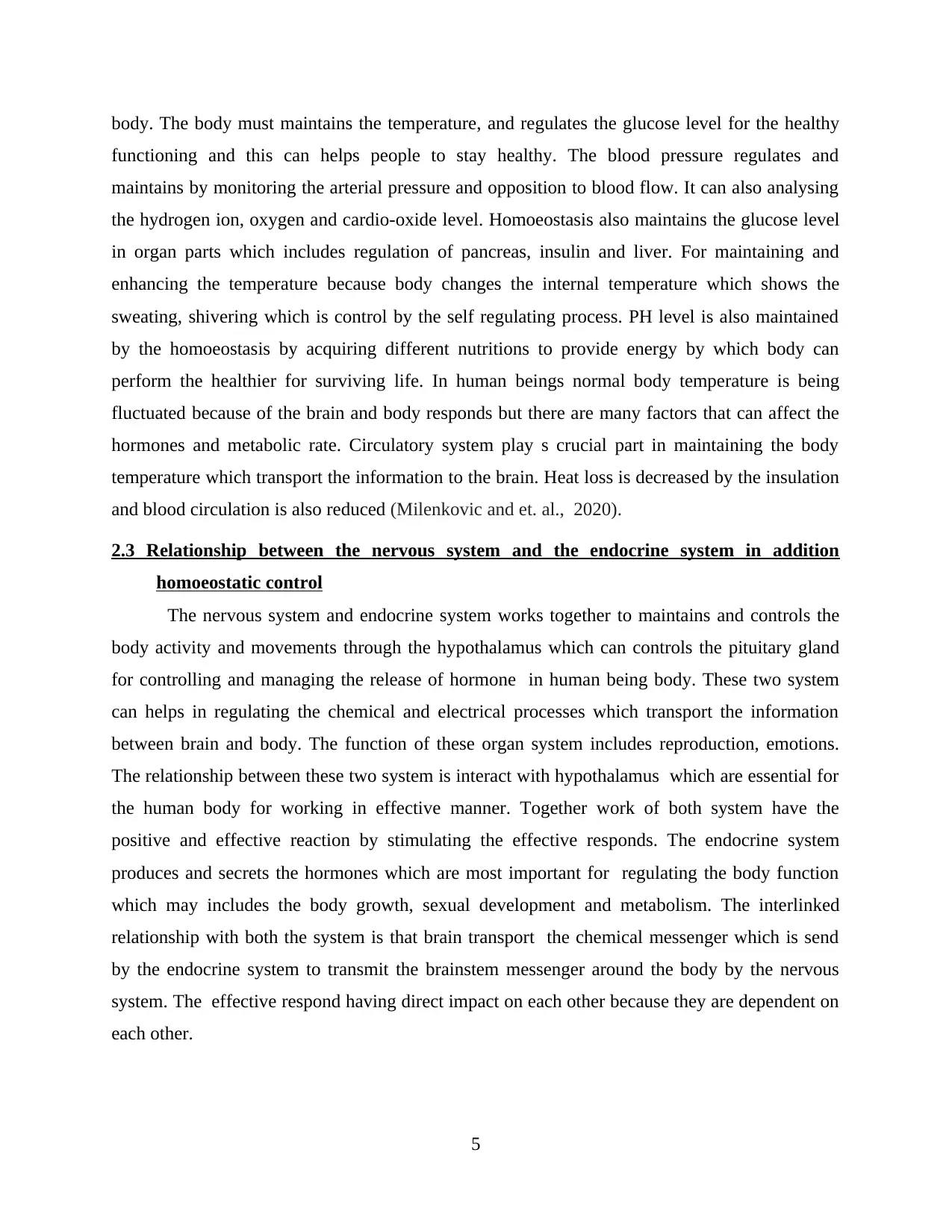
body. The body must maintains the temperature, and regulates the glucose level for the healthy
functioning and this can helps people to stay healthy. The blood pressure regulates and
maintains by monitoring the arterial pressure and opposition to blood flow. It can also analysing
the hydrogen ion, oxygen and cardio-oxide level. Homoeostasis also maintains the glucose level
in organ parts which includes regulation of pancreas, insulin and liver. For maintaining and
enhancing the temperature because body changes the internal temperature which shows the
sweating, shivering which is control by the self regulating process. PH level is also maintained
by the homoeostasis by acquiring different nutritions to provide energy by which body can
perform the healthier for surviving life. In human beings normal body temperature is being
fluctuated because of the brain and body responds but there are many factors that can affect the
hormones and metabolic rate. Circulatory system play s crucial part in maintaining the body
temperature which transport the information to the brain. Heat loss is decreased by the insulation
and blood circulation is also reduced (Milenkovic and et. al., 2020).
2.3 Relationship between the nervous system and the endocrine system in addition
homoeostatic control
The nervous system and endocrine system works together to maintains and controls the
body activity and movements through the hypothalamus which can controls the pituitary gland
for controlling and managing the release of hormone in human being body. These two system
can helps in regulating the chemical and electrical processes which transport the information
between brain and body. The function of these organ system includes reproduction, emotions.
The relationship between these two system is interact with hypothalamus which are essential for
the human body for working in effective manner. Together work of both system have the
positive and effective reaction by stimulating the effective responds. The endocrine system
produces and secrets the hormones which are most important for regulating the body function
which may includes the body growth, sexual development and metabolism. The interlinked
relationship with both the system is that brain transport the chemical messenger which is send
by the endocrine system to transmit the brainstem messenger around the body by the nervous
system. The effective respond having direct impact on each other because they are dependent on
each other.
5
functioning and this can helps people to stay healthy. The blood pressure regulates and
maintains by monitoring the arterial pressure and opposition to blood flow. It can also analysing
the hydrogen ion, oxygen and cardio-oxide level. Homoeostasis also maintains the glucose level
in organ parts which includes regulation of pancreas, insulin and liver. For maintaining and
enhancing the temperature because body changes the internal temperature which shows the
sweating, shivering which is control by the self regulating process. PH level is also maintained
by the homoeostasis by acquiring different nutritions to provide energy by which body can
perform the healthier for surviving life. In human beings normal body temperature is being
fluctuated because of the brain and body responds but there are many factors that can affect the
hormones and metabolic rate. Circulatory system play s crucial part in maintaining the body
temperature which transport the information to the brain. Heat loss is decreased by the insulation
and blood circulation is also reduced (Milenkovic and et. al., 2020).
2.3 Relationship between the nervous system and the endocrine system in addition
homoeostatic control
The nervous system and endocrine system works together to maintains and controls the
body activity and movements through the hypothalamus which can controls the pituitary gland
for controlling and managing the release of hormone in human being body. These two system
can helps in regulating the chemical and electrical processes which transport the information
between brain and body. The function of these organ system includes reproduction, emotions.
The relationship between these two system is interact with hypothalamus which are essential for
the human body for working in effective manner. Together work of both system have the
positive and effective reaction by stimulating the effective responds. The endocrine system
produces and secrets the hormones which are most important for regulating the body function
which may includes the body growth, sexual development and metabolism. The interlinked
relationship with both the system is that brain transport the chemical messenger which is send
by the endocrine system to transmit the brainstem messenger around the body by the nervous
system. The effective respond having direct impact on each other because they are dependent on
each other.
5
Paraphrase This Document
Need a fresh take? Get an instant paraphrase of this document with our AI Paraphraser
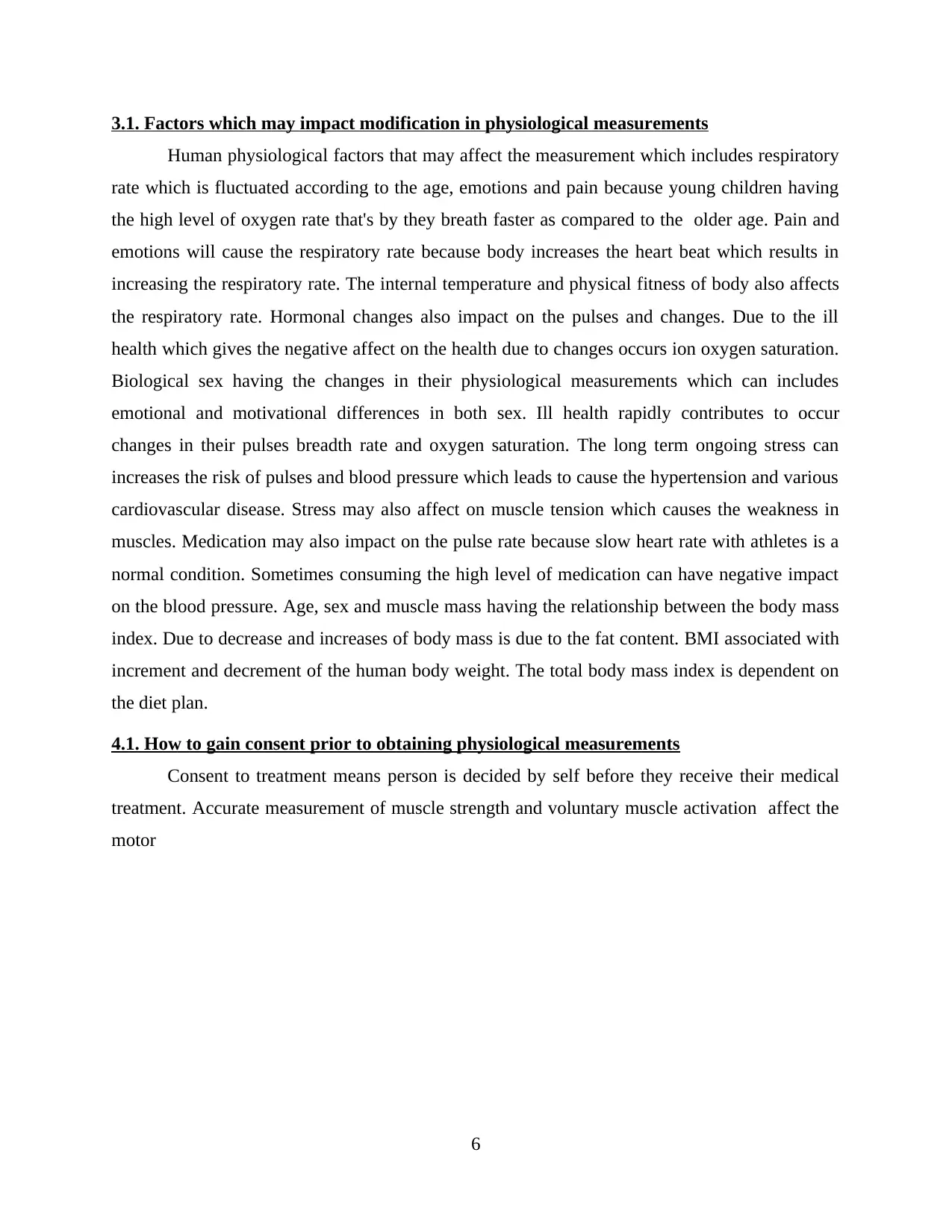
3.1. Factors which may impact modification in physiological measurements
Human physiological factors that may affect the measurement which includes respiratory
rate which is fluctuated according to the age, emotions and pain because young children having
the high level of oxygen rate that's by they breath faster as compared to the older age. Pain and
emotions will cause the respiratory rate because body increases the heart beat which results in
increasing the respiratory rate. The internal temperature and physical fitness of body also affects
the respiratory rate. Hormonal changes also impact on the pulses and changes. Due to the ill
health which gives the negative affect on the health due to changes occurs ion oxygen saturation.
Biological sex having the changes in their physiological measurements which can includes
emotional and motivational differences in both sex. Ill health rapidly contributes to occur
changes in their pulses breadth rate and oxygen saturation. The long term ongoing stress can
increases the risk of pulses and blood pressure which leads to cause the hypertension and various
cardiovascular disease. Stress may also affect on muscle tension which causes the weakness in
muscles. Medication may also impact on the pulse rate because slow heart rate with athletes is a
normal condition. Sometimes consuming the high level of medication can have negative impact
on the blood pressure. Age, sex and muscle mass having the relationship between the body mass
index. Due to decrease and increases of body mass is due to the fat content. BMI associated with
increment and decrement of the human body weight. The total body mass index is dependent on
the diet plan.
4.1. How to gain consent prior to obtaining physiological measurements
Consent to treatment means person is decided by self before they receive their medical
treatment. Accurate measurement of muscle strength and voluntary muscle activation affect the
motor
6
Human physiological factors that may affect the measurement which includes respiratory
rate which is fluctuated according to the age, emotions and pain because young children having
the high level of oxygen rate that's by they breath faster as compared to the older age. Pain and
emotions will cause the respiratory rate because body increases the heart beat which results in
increasing the respiratory rate. The internal temperature and physical fitness of body also affects
the respiratory rate. Hormonal changes also impact on the pulses and changes. Due to the ill
health which gives the negative affect on the health due to changes occurs ion oxygen saturation.
Biological sex having the changes in their physiological measurements which can includes
emotional and motivational differences in both sex. Ill health rapidly contributes to occur
changes in their pulses breadth rate and oxygen saturation. The long term ongoing stress can
increases the risk of pulses and blood pressure which leads to cause the hypertension and various
cardiovascular disease. Stress may also affect on muscle tension which causes the weakness in
muscles. Medication may also impact on the pulse rate because slow heart rate with athletes is a
normal condition. Sometimes consuming the high level of medication can have negative impact
on the blood pressure. Age, sex and muscle mass having the relationship between the body mass
index. Due to decrease and increases of body mass is due to the fat content. BMI associated with
increment and decrement of the human body weight. The total body mass index is dependent on
the diet plan.
4.1. How to gain consent prior to obtaining physiological measurements
Consent to treatment means person is decided by self before they receive their medical
treatment. Accurate measurement of muscle strength and voluntary muscle activation affect the
motor
6
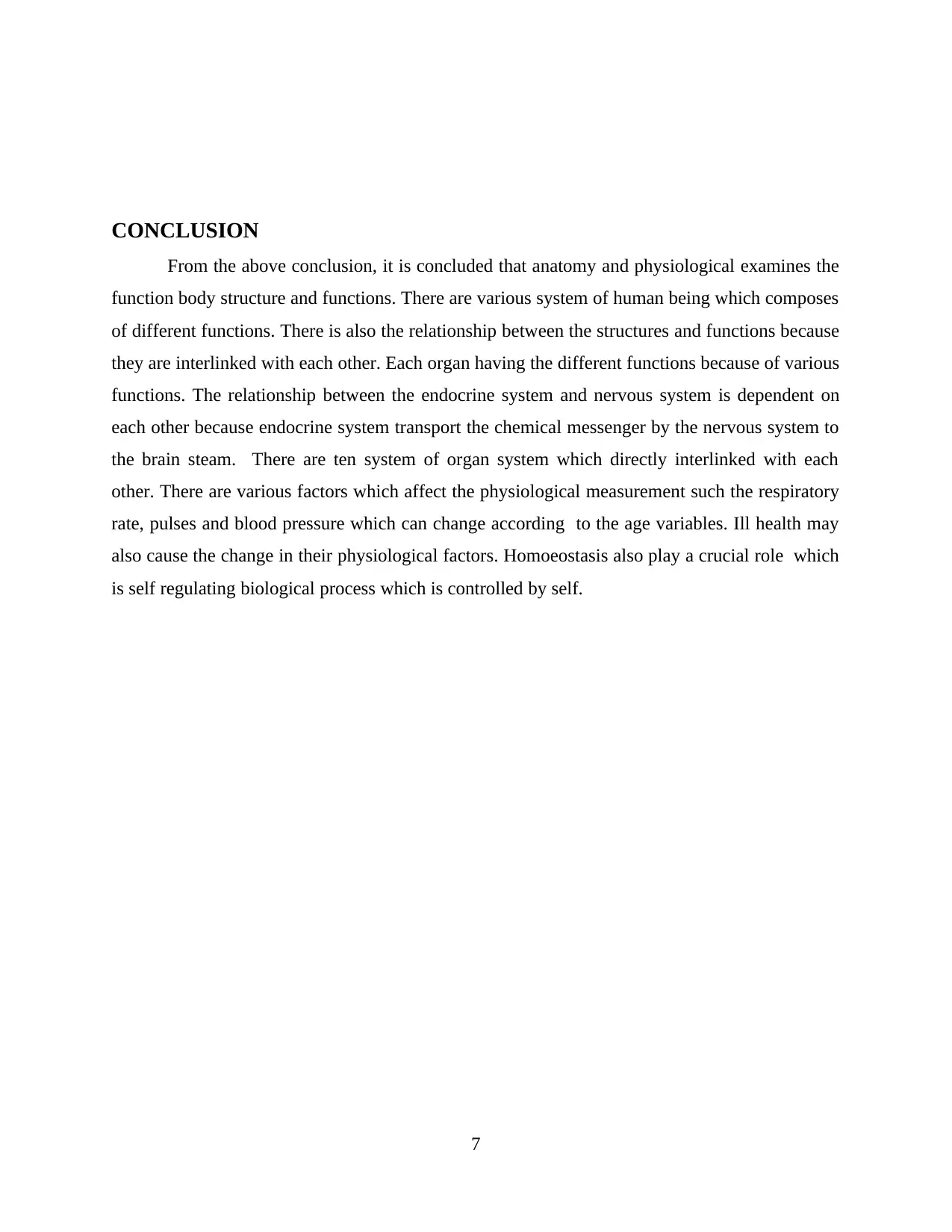
CONCLUSION
From the above conclusion, it is concluded that anatomy and physiological examines the
function body structure and functions. There are various system of human being which composes
of different functions. There is also the relationship between the structures and functions because
they are interlinked with each other. Each organ having the different functions because of various
functions. The relationship between the endocrine system and nervous system is dependent on
each other because endocrine system transport the chemical messenger by the nervous system to
the brain steam. There are ten system of organ system which directly interlinked with each
other. There are various factors which affect the physiological measurement such the respiratory
rate, pulses and blood pressure which can change according to the age variables. Ill health may
also cause the change in their physiological factors. Homoeostasis also play a crucial role which
is self regulating biological process which is controlled by self.
7
From the above conclusion, it is concluded that anatomy and physiological examines the
function body structure and functions. There are various system of human being which composes
of different functions. There is also the relationship between the structures and functions because
they are interlinked with each other. Each organ having the different functions because of various
functions. The relationship between the endocrine system and nervous system is dependent on
each other because endocrine system transport the chemical messenger by the nervous system to
the brain steam. There are ten system of organ system which directly interlinked with each
other. There are various factors which affect the physiological measurement such the respiratory
rate, pulses and blood pressure which can change according to the age variables. Ill health may
also cause the change in their physiological factors. Homoeostasis also play a crucial role which
is self regulating biological process which is controlled by self.
7
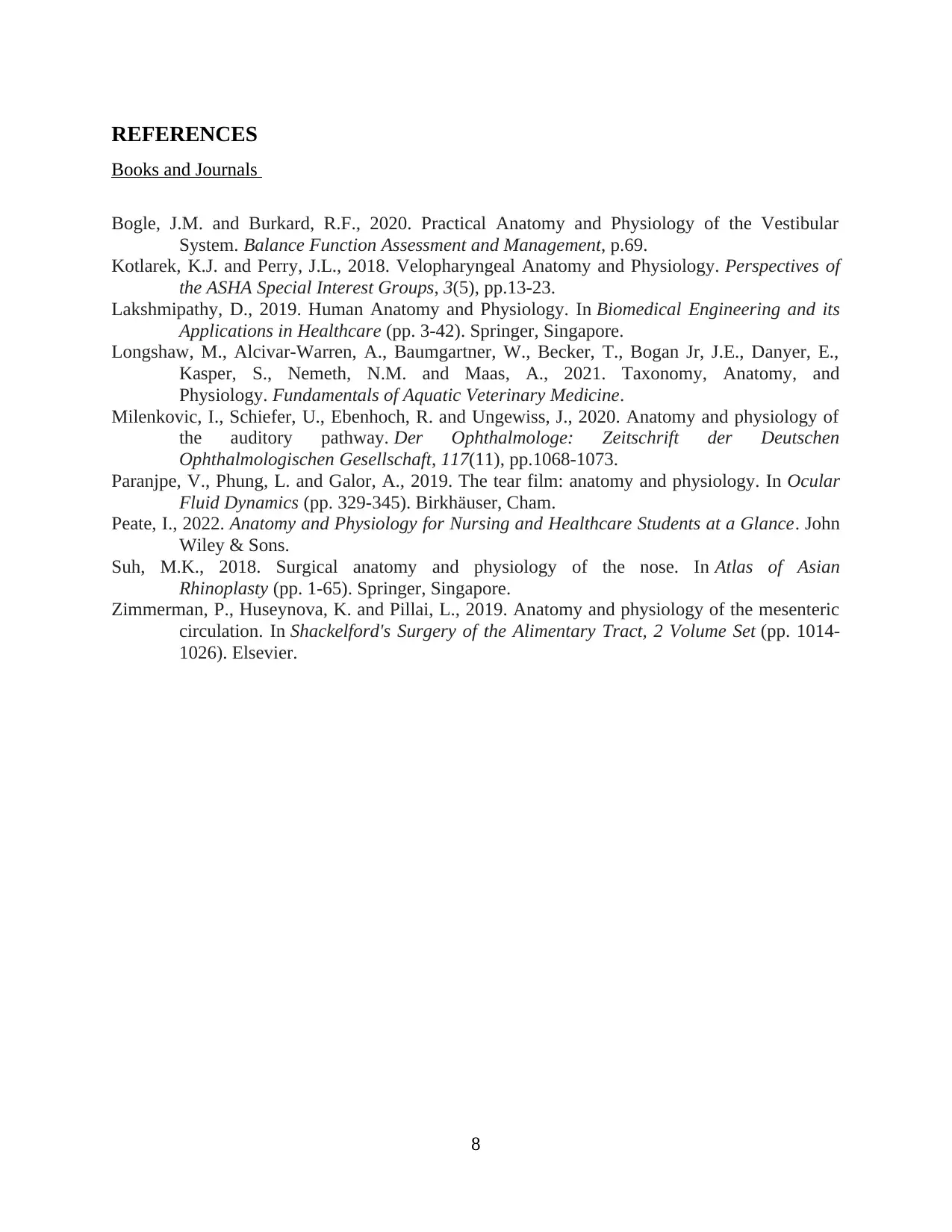
REFERENCES
Books and Journals
Bogle, J.M. and Burkard, R.F., 2020. Practical Anatomy and Physiology of the Vestibular
System. Balance Function Assessment and Management, p.69.
Kotlarek, K.J. and Perry, J.L., 2018. Velopharyngeal Anatomy and Physiology. Perspectives of
the ASHA Special Interest Groups, 3(5), pp.13-23.
Lakshmipathy, D., 2019. Human Anatomy and Physiology. In Biomedical Engineering and its
Applications in Healthcare (pp. 3-42). Springer, Singapore.
Longshaw, M., Alcivar-Warren, A., Baumgartner, W., Becker, T., Bogan Jr, J.E., Danyer, E.,
Kasper, S., Nemeth, N.M. and Maas, A., 2021. Taxonomy, Anatomy, and
Physiology. Fundamentals of Aquatic Veterinary Medicine.
Milenkovic, I., Schiefer, U., Ebenhoch, R. and Ungewiss, J., 2020. Anatomy and physiology of
the auditory pathway. Der Ophthalmologe: Zeitschrift der Deutschen
Ophthalmologischen Gesellschaft, 117(11), pp.1068-1073.
Paranjpe, V., Phung, L. and Galor, A., 2019. The tear film: anatomy and physiology. In Ocular
Fluid Dynamics (pp. 329-345). Birkhäuser, Cham.
Peate, I., 2022. Anatomy and Physiology for Nursing and Healthcare Students at a Glance. John
Wiley & Sons.
Suh, M.K., 2018. Surgical anatomy and physiology of the nose. In Atlas of Asian
Rhinoplasty (pp. 1-65). Springer, Singapore.
Zimmerman, P., Huseynova, K. and Pillai, L., 2019. Anatomy and physiology of the mesenteric
circulation. In Shackelford's Surgery of the Alimentary Tract, 2 Volume Set (pp. 1014-
1026). Elsevier.
8
Books and Journals
Bogle, J.M. and Burkard, R.F., 2020. Practical Anatomy and Physiology of the Vestibular
System. Balance Function Assessment and Management, p.69.
Kotlarek, K.J. and Perry, J.L., 2018. Velopharyngeal Anatomy and Physiology. Perspectives of
the ASHA Special Interest Groups, 3(5), pp.13-23.
Lakshmipathy, D., 2019. Human Anatomy and Physiology. In Biomedical Engineering and its
Applications in Healthcare (pp. 3-42). Springer, Singapore.
Longshaw, M., Alcivar-Warren, A., Baumgartner, W., Becker, T., Bogan Jr, J.E., Danyer, E.,
Kasper, S., Nemeth, N.M. and Maas, A., 2021. Taxonomy, Anatomy, and
Physiology. Fundamentals of Aquatic Veterinary Medicine.
Milenkovic, I., Schiefer, U., Ebenhoch, R. and Ungewiss, J., 2020. Anatomy and physiology of
the auditory pathway. Der Ophthalmologe: Zeitschrift der Deutschen
Ophthalmologischen Gesellschaft, 117(11), pp.1068-1073.
Paranjpe, V., Phung, L. and Galor, A., 2019. The tear film: anatomy and physiology. In Ocular
Fluid Dynamics (pp. 329-345). Birkhäuser, Cham.
Peate, I., 2022. Anatomy and Physiology for Nursing and Healthcare Students at a Glance. John
Wiley & Sons.
Suh, M.K., 2018. Surgical anatomy and physiology of the nose. In Atlas of Asian
Rhinoplasty (pp. 1-65). Springer, Singapore.
Zimmerman, P., Huseynova, K. and Pillai, L., 2019. Anatomy and physiology of the mesenteric
circulation. In Shackelford's Surgery of the Alimentary Tract, 2 Volume Set (pp. 1014-
1026). Elsevier.
8
1 out of 10
Related Documents
Your All-in-One AI-Powered Toolkit for Academic Success.
+13062052269
info@desklib.com
Available 24*7 on WhatsApp / Email
![[object Object]](/_next/static/media/star-bottom.7253800d.svg)
Unlock your academic potential
© 2024 | Zucol Services PVT LTD | All rights reserved.





